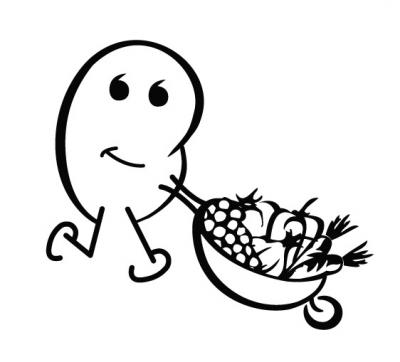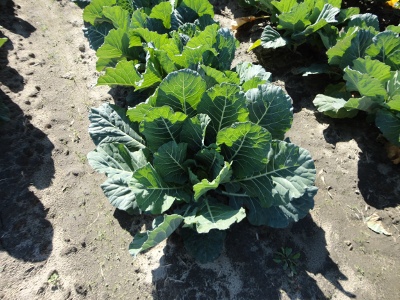 Rob M.
Rob M. | December Produce Tips and Storage
Dec 7, 2011 at 8:22 pm |
Mustard Greens: Mustard greens are considered to be just as healthy and nutrient packed as other cruciferous vegetables, like collards and kale, but haven't gotten the same kind of press for it. They can be prepared as you would other greens, sauteed, boiled, or steamed. For more interesting options, consider taking a look at Indian or Chinese cuisine where they are use frequently. Like other greens, it's best to store mustard greens in a plastic bag to prevent moisture loss, and they should be refrigerated.
Cabbage: If possible, do not remove outer leaves from cabbage. Outer leaves protect interior from damage and from moisture loss. However, if refrigerator space is an issue, you can remove the outer leaves, and will have a smaller head of cabbage, just know that it won't keep quite as well. Cabbage can be used in portions, but once you cut into the interior of the cabbage, you will need to wrap the remaining portion tightly in saran wrap. Cabbage is a versatile vegetable that can be used raw as in coleslaw or cooked in a variety of ways. Cabbage is a food staple and is used in many types of cuisine.
Celery Root: Celery root is a root vegetable, and as such is best stored in a cool dark environment. Moisture loss will be the biggest threat to the longevity of your celery root, so keep it in a plastic bag. However, celery root will keep for many weeks under proper conditions. Celery root can be eaten raw or cooked. First cut off the tough, furrowed, outer layer. The interior bulb has a celery flavor, and is commonly pureed for use in soups, or mashed, sliced, cubed, in most ways that you would prepare a potato. The flavor is delicate, and pairs well with garlic and/or fresh herbs.
Turnips: Turnips have a sweet, slightly peppery taste. They should be stored in the refrigerator, in a plastic bag to prevent moisture loss. Smaller turnips are sweeter, and more tender, but tend to lose moisture and go bad the quickest. Use small turnips first. Larger turnips are not quite as tender, and will need to be peeled, but will keep for 1-2 weeks. If the greens are attached, remove them and store them separately, as they will suck moisture out of the turnip root.
Rutabagas: Rutabagas have a sweet taste, without the peppery undertones of turnips. They should be refrigerated, and generally last longer than turnips as their thicker skins protect better from moisture loss. Rutabagas should be peeled before using. Roasting will concentrate their flavor, while boiling will dilute it. Look to Northern and Eastern Europe for inspiration on rutabaga cuisine.
Radishes: Remove tops from radishes to prevent moisture loss. Radishes should be stored in the refrigerator, and will keep for up to a week. Radishes have a peppery flavor that usually goes well in salads or in appetizers. The peppery flavor stimulated the production of saliva and rouses flavor, making them a good addition to pre-entree dishes. A simple radish appetizers includes sliced radishes served with melted butter and salt on the side. The peppery flavor is most concentrated in the radish skin, so they can be peeled for a milder flavor. Radish greens can also be used raw in salads, or cooked as you would other greens.
Broccoli: Broccoli should be stored in the refrigerator where it will keep for 4-5 days. Like most vegetables, broccoli will lose moisture as it ages, which you want to protect against, but you also want the broccoli to be able to breathe, so it is not a good idea to enclose it in plastic. A perforated plastic bag, or just an open plastic bag are usually the best options. During commercial transport, broccoli is packed on ice which keeps moisture level high, and temperature as close to freezing as possible, while still allowing the broccoli to breathe. However, this usually isn't practical at home. Broccoli takes very well to freezing (if blanched first), so you may consider freezing broccoli if unable to use it within a few days.
Strawberries: Check for any damaged or bruised strawberries, and remove them from the container. Damaged fruits release ethylene gas which signals other fruits to ripen at a faster rate. This means that one bad apple really does spoil the bunch. Berries can go bad quite quickly, so make sure they are covered, and store them in the coldest part of the refrigerator. However, strawberries will be at their juiciest at room temperature, so if possible bring them to room temperature prior to consuming.
Like this? 5.00 (2 ratings) Tracie D. (Dec 9, 2011 at 4:53 pm)I love these types of articles, esp for produce we're learning about and trying for first time Rob M. (Dec 10, 2011 at 2:23 pm)Glad to hear these are helpful. We'll try to do these more frequently. Maybe once every 4-6 weeks. |   (Rob M.) (Rob M.) |